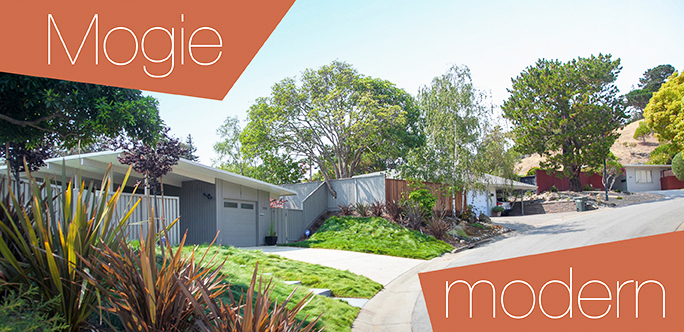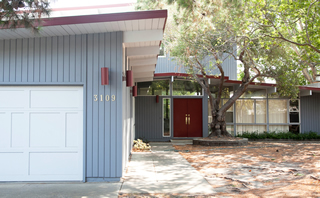Mogie Modern
 |
|
|
It's one of the loveliest little enclaves of modernism on the San Francisco Peninsula—a dozen homes with a style all their own, hidden on a whiptail cul-de-sac. Visitors sometimes call them 'Eichlers,' but residents on this street know better.
"We'll correct them," says Karen Maskel, who has lived in one of the homes for 30 years with her husband Steve. "No, it's a Mogensen."
It's a term fans of architect Mogens Mogensen often use to refer to his homes. If we lived in a perfect world, 'Mogensens' would be as common today, and as popular, as Eichlers.
That they are not speaks less to the quality of Mogensen's architecture, or to his ambitions, than to the daring that allowed Joe Eichler to build the 11,000 purely modern homes that he did, a daring other developers lacked.
 |
|
|
It's clear that Mogensen (1920-1997) wanted to build modern tract homes. Sunset Terrace, as the San Mateo enclave is called, proves it, as do renderings and plans Mogensen drew for other tract homes throughout his career.
Few got built—and those that did emerged in a form much more traditional than Mogensen's original designs.
Holding back Mogensen's modern proclivities was his boss, David Bohannon, who operated the David D. Bohannon Organization, one of the largest homebuilders in the Bay Area, far eclipsing Eichler.
A forward-thinking developer, inventor in the 1920s and '30s of what the building press called 'the California Method' of mass-production homebuilding, Bohannon appreciated modern architecture. He so loved the 'Model Home of the World,' designed for the 1939 Golden Gate International Exposition by pioneering modernist Gardner Dailey, that he bought and barged it across the Bay to serve as the family home.
But when it came to tract homes, Bohannon concentrated on what he knew would have a broad appeal, conservatively styled ranch-style and quasi-ranch-style homes.
That's not to say that Mogie, as friends knew him, couldn't get away with something modern on occasion, like a bebop player stuck in a society dance band periodically ripping off a few fast and angular arpeggios.
And it's not as though Bohannon was Mogensen's only outlet for the modernism that was burning in his soul. Throughout the Peninsula, and to lesser extent elsewhere in the Bay Area and Northern California, he dotted the landscape with stylish office buildings, custom homes, and, what he's best known for, apartment houses. "That's where he shined, I think, with multifamily," says Dick Foster, a friend and one of the developers behind Foster City.
"I really like Mr. Mogensen's work," San Francisco architectural historian Gary Goss says of the apartments. "I love the modernity of the buildings. They just don't date at all. They're still so sweet and beautiful, 50 and 60 years later."
Bohannon played up the architect's reputation in his ads. 'Glamorous apartments,' proclaimed an ad in the 1958 San Jose Mercury News, by "award-winning Danish architect Mogens Mogensen."




